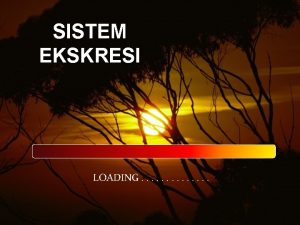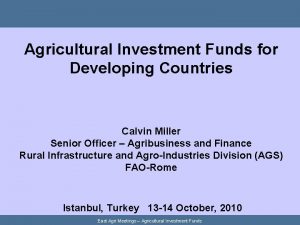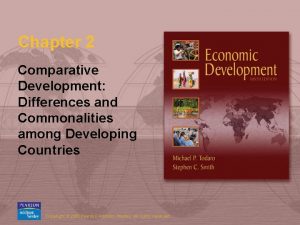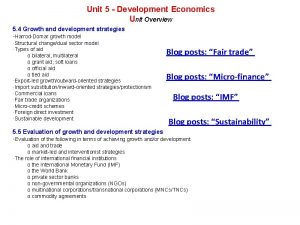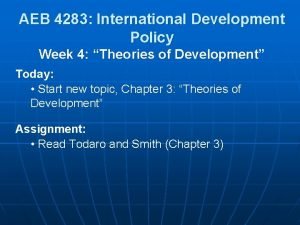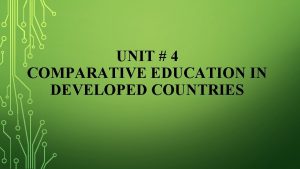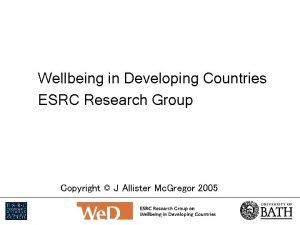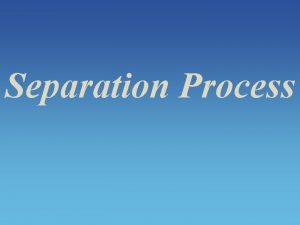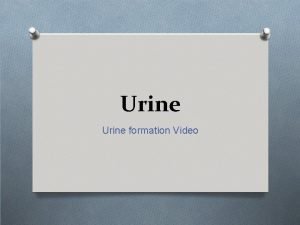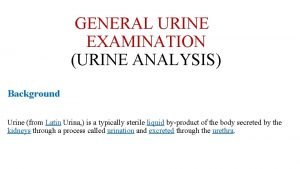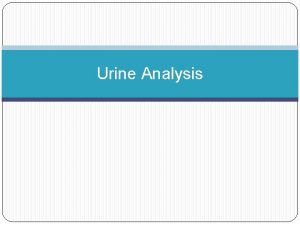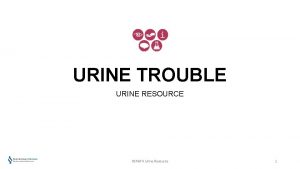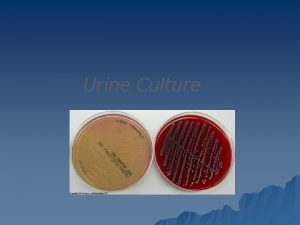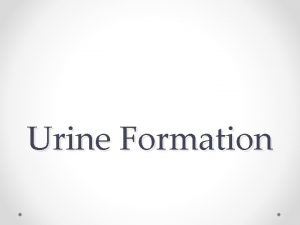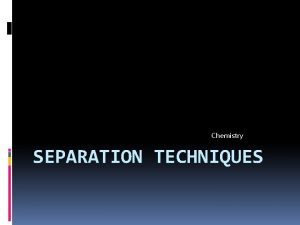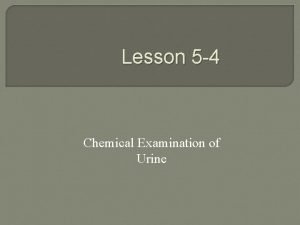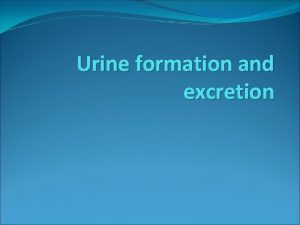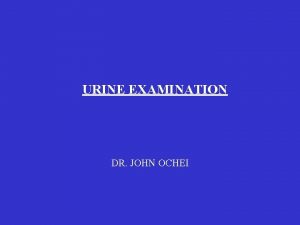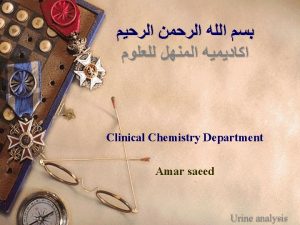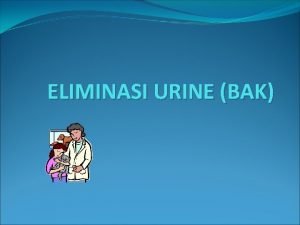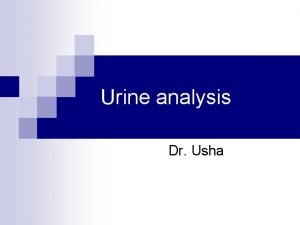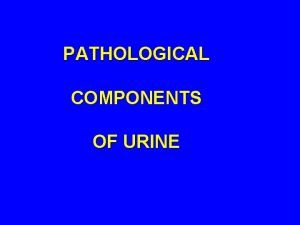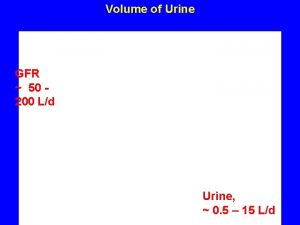Urine Separation Opportunities for developing countries 1 UNESCOIHE





















- Slides: 21

Urine Separation - Opportunities for developing countries 1

UNESCO-IHE § § § Institute for Water Education Owned by all UNESCO member states Every year 200 MSc degrees Currently 100 Ph. D students Tailor made training, online courses, curriculum development § Research 2

Urine separation § Part of Wastewater Design 3

Distribution volume and concentrations Volume (L/cap. year) WATER NUTRIENTS COD

Motivations for urine separation § § § Increase capacity of existing WWTPs Reduction water demand Prevention discharge large part of micropollutants Enable recycling before treatment Prevention pathogen mobilisation in onsite systems 5

Nutrients in urine Problem Nitrogen Phosphorus Opportunity eutrophication complete fertiliser Potassium Sulphur Calcium Magnesium Micronutrients benefit over artificial fertiliser Oil of the future 6

Technologies available Depends on goal! § § Nutrient removal Nutrient recovery Hygienisation Stabilisation; volume reduction 7

Urine change during storage Before storage Na opslag urea mg/l 7600 0 ammonium mg/l 480 8000 phosphate mg/l 740 540 magnesium mg/l 100 0 calcium mg/l 180 0 bicarbonate mg/l 0 3200 alkalinity mg/l 22 490 - 6. 2 9. 1 p. H

Urine change during storage Before storage After storage urea mg/l 7600 0 ammonium mg/l 480 8000 phosphate mg/l 740 540 magnesium mg/l 100 0 calcium mg/l 180 0 bicarbonate mg/l 0 3200 alkalinity mg/l 22 490 - 6. 2 9. 1 p. H

Hygienisation § § Storage! Prevent High p. H dilution High ammonia concentration Temperature best kept > 20°C 10

Nutrient removal Standard removal techniques can be applied § Nitrification / denitrification § Phosphate removal 11

Nutrient recovery: struvite NH 4+ + PO 43 - + Mg 2+ → Mg. NH 4 PO 4

Struvite precipitation applied full scale § Japan, Canada, USA (Ostara) § Netherlands: industrial WWT (potato) § Nepal: with urine from UDD toilets Crystal. Green. TM Several possibilities for SMEs STUN Project, Nepal – www. sandec. ch

Most obvious benefit: stop mobility pathogens Drawings by Albert Oleja, Uganda

Direct benefits, even without treatment § Prevention leakage nutrients + pathogens to groundwater -> helps drinking water treatment! § Makes urine available for clean and easy transport § Enabling safe handling (dried faecal matter 80% volume reduction) § Reduction pit emptying frequency 15

Conclusion § Urine separation: benefits for centralised and decentralised systems § Treatment urine: with standard techniques § After hygienisation: direct use as fertiliser § Direct benefits, even without treatment 16

Thank you for your attention 17

We know struvite precipitates spontaneously – can we also use it?

Chemical contaminants in urine § Heavy metals (Cu, Zn, Cr, Ni, Pb, Cd) § Hormones (endocrine disrupters) and pharmaceuticals: § Average of 64% of a substance ingested is excreted in the urine (Escher, 2007, p. 24) Better to recycle urine to arable land than to flush into recipient waters because: • Hormones and pharmaceuticals are degraded in natural environments with a diverse microbial activity • Urine is mixed into the active topsoil and retained for months (see Course 3 “Reuse of ecosan products in agriculture”) 19

What you excrete vs what you need Values are country-specific or diet-specific (treat as guideline only!) cap = capita = person 20

Visual evidence faeces & urine Maize (corn) urine none compost improved soil untreated soil after one week without water Source: GTZ presentations 21
 Dari hasil tes urine ternyata urine pak amir
Dari hasil tes urine ternyata urine pak amir Difference between developing and underdeveloped countries
Difference between developing and underdeveloped countries Calvin miller coltivare
Calvin miller coltivare Poor wesley 015
Poor wesley 015 Five stages of economic growth
Five stages of economic growth Harrod domar model
Harrod domar model Comparative education in developing countries
Comparative education in developing countries Material well being
Material well being Sju för caesar
Sju för caesar Stig kerman
Stig kerman Strategi för svensk viltförvaltning
Strategi för svensk viltförvaltning Nationell inriktning för artificiell intelligens
Nationell inriktning för artificiell intelligens Ledningssystem för verksamhetsinformation
Ledningssystem för verksamhetsinformation Tack för att ni har lyssnat
Tack för att ni har lyssnat Centrum för kunskap och säkerhet
Centrum för kunskap och säkerhet Läkarutlåtande för livränta
Läkarutlåtande för livränta Personalliggare bygg undantag
Personalliggare bygg undantag Inköpsprocessen steg för steg
Inköpsprocessen steg för steg Påbyggnader för flakfordon
Påbyggnader för flakfordon Egg för emanuel
Egg för emanuel Sura för anatom
Sura för anatom Variansen formel
Variansen formel
